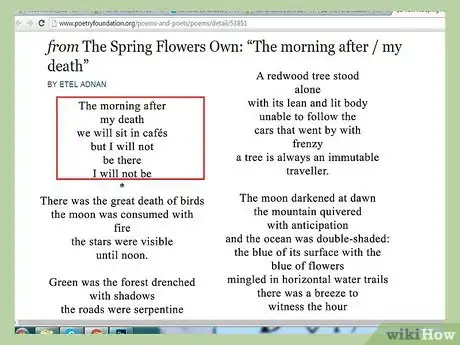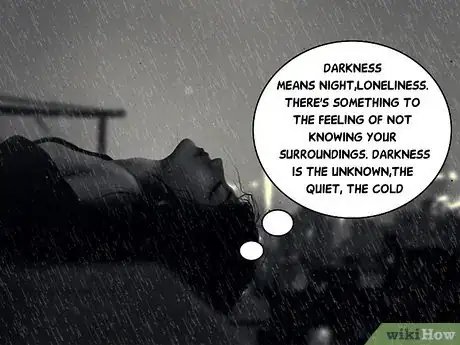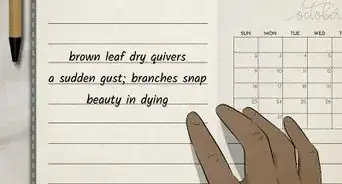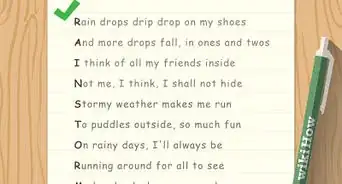This article was co-authored by Stephanie Wong Ken, MFA. Stephanie Wong Ken is a writer based in Canada. Stephanie's writing has appeared in Joyland, Catapult, Pithead Chapel, Cosmonaut's Avenue, and other publications. She holds an MFA in Fiction and Creative Writing from Portland State University.
There are 10 references cited in this article, which can be found at the bottom of the page.
wikiHow marks an article as reader-approved once it receives enough positive feedback. In this case, several readers have written to tell us that this article was helpful to them, earning it our reader-approved status.
This article has been viewed 150,410 times.
Dark poetry can be a good way to express any deep, dark emotions you are experiencing. To write dark poems, you should first get a better sense of the common themes of many popular dark poems, brainstorm your ideas for the poem and then create your dark poem.
Steps
Understanding the Themes and Styles of Dark Poems
-
1Learn the common themes in dark poetry. Most dark poetry focuses on emotions that may be morbid or disturbing. This could be feelings of loss, loneliness, death, depression, or anxiety. Dark poetry can act as a way to release these feelings and process these emotions. Many poets find dark poetry cathartic, almost like a form of therapy.[1] [2]
- There is also a sense of longing in dark poetry, as many dark poems romanticize death or dying. Often, poets see death existing right next to life. Death may be given sexual undertones or be portrayed as a figure of romance, but in a dark way.
-
2Read examples of dark poetry. There are many examples of dark poetry, as this genre of poetry is popular among many different poets throughout literature. You may read several examples to get a better sense of the style and tone found in dark poems, including:[3]Advertisement
-
3Analyze the examples. Once you have read over the examples, you should think about how each poet discusses darkness or dark themes in their work. Some poets may view darkness in terms of love and loss or darkness as more of a concept, where the speaker sees darkness in everyday moments or events.
- Ask yourself several questions about the poems, such as: How does the poet explore darkness in the poem? Does the poet focus on a specific moment of darkness? How does the poet use sensory detail and descriptive language to describe darkness?
- For example, in Rossetti’s “Song”, Rossetti asks her lover not to mourn her death, but instead to move on with their life. Rossetti romanticizes death by arguing it has no domain over her once she is gone. She also uses rhyme and rhythm to give the poem a light quality, even when it is addressing heavy themes.
- In comparison, Hughes’ “Minstrel Man” looks at how minstrel shows in America hide a lot of darkness in plain sight. His speaker is a minstrel man who performs racist shows for American audiences. Hughes contrasts the apparent joy and happiness the minstrel man performs for his audience with the pain and suffering he experiences internally. This gives the poem a disturbing quality that is finalized with the last line of the poem, “I die”.
Brainstorming Ideas for the Poem
-
1Make a list of keywords that relate to darkness. To get your creative juices flowing, it may help to list keywords that relate to darkness and dark themes. Write darkness in the center of a piece of paper and then list words around the center that relate to darkness. Do not try to edit to your list or think too much as you write. The idea is to generate terms and words that conjure up darkness for you, which you can then use later when you sit down to write your poem.[7]
- For example, around “darkness”, you may write “black”, “grey”, “death” “alone”, “anger”, “powerful”, and “hidden”. You could then try to integrate these terms into your poem or use a specific feeling, such as “anger”, as the inspiration for your poem.
-
2Remember a moment when you felt sad, lonely, or depressed. One way to brainstorm ideas for your poem is to think about a specific moment when you experienced dark emotions, such as sadness, loneliness, or depression. Focusing on one specific moment and writing down words that relate to that moment can help you get ideas for the voice and tone of your poem.
- For example, maybe you recall a moment in the girl’s bathroom at school where you felt lonely or sad. You may then try to describe the scene and how it felt to be standing in the girl’s bathroom with these feelings.
-
3Focus on a specific dark event. You may also decide to write about an event in your life that was particularly dark or difficult. Try to rely on your memories of the event and write about this event from your perspective. Doing this will make the poem feel intimate and honest.[8]
- For example, maybe you relate a lot of dark emotions to the death of your grandfather. You may then try describing how it felt to attend his funeral and see him in his casket. You may also contrast memories of his death with memories of his life to give the poem levity.
-
4Describe a person or place that signifies darkness to you. You may also focus on a specific person or place that represents darkness to you. Maybe a person pops into your head as soon as you think of darkness or a specific location that you have visited in the past. Describing a tangible thing, such as a person or place, can help you hone in on specific images for your poem.[9]
- For example, maybe there is a next door neighbor who seems to represent darkness or dark emotions for you. Or, maybe there is a family relative that scared you as a kid. You may also remember a dark experience in a house you once lived in or associate dark feelings with a house in your neighborhood. Maybe there was a family vacation that you went on to a specific place in the States that you associate with dark or disturbing emotions.
Writing the Poem
-
1Avoid cliches. When you are writing about subjects like darkness, sadness, loneliness, and death, it can be hard not to fall into cliches and familiar language. A cliche is a description that has been so overused it has lost its meaning.[10] Many readers will gloss over a cliche and/or question the poet’s creativity when they come across a cliche. Avoid leaning on cliches in your writing and focus on creating more unique and unfamiliar ways of approaching darkness.[11]
- Try to stay away from cliches like “dark as night”, “lost and alone” or “so lonesome I could cry”. Come up with more original descriptions and images in your poem, especially when you are addressing dark themes and elements.
- One way you can address cliches in your writing is to go over your poem and look for any familiar terms or phrases. You should then underline them and focus on replacing certain words or replacing the phrase so it is less familiar and feels more original.
-
2Add sensory detail. Make sure you are using sensory detail in your poem, as this will make the poem come alive and contain descriptions that are memorable. Think about how a moment looks, sounds, tastes, smells, or feels. Use all five senses to create detailed moments in your poem.[12]
- For example, maybe you are writing a poem about your grandfather’s death. You may focus on the smell of the white lilies at his grave or the gray, thin appearance of your grandfather in his casket. You may also describe the food you ate at his wake and the feeling of holding your grandmother’s hand at the funeral.
-
3Use literary devices. Literary devices like metaphor, simile, and rhyme can help to strengthen the language in your poem and add depth to your writing. Try to use literary devices strategically, especially in a shorter poem. Every line should not be full of metaphors or similes only. You should vary up how you use these literary devices so your poem still flows well and does not seem wordy or long-winded.[13]
- For example, you may use a metaphor to describe the loneliness of standing in the girl’s bathroom at school. You may write, “The stalls are blank eyes in the face of this room”. Or, you may use a simile to describe the look and smell of the bathroom. You may write, “The floor is as slick as the surface of a lake” and “The sinks smell like rotten eggs”.
- Some poets, such as Rossetti in “Song”, also use rhyme in their dark poetry. Rhyme can be useful for adding some levity and lightness to a poem about heavy, dark subject matter. But it can also make your poem sound too sing-songy and silly. Use rhyme sparingly.
-
4Read your poem out loud. Once you have written your first draft, you should read your poem out loud to yourself or to a sympathetic audience. Listen for any awkward phrases or words and highlight them. Ask the listener for feedback on your writing.
- You should also pay attention to any images that are confusing or lines that are not as strong as they could be. Make sure you are not using cliches in your writing. Your poem should use unfamiliar and interesting images and descriptions that are true to your style and voice.
- You should go back and edit the poem for clarity once you have read it out loud. Adjust any problem phrases or words you identified and make sure you are using strong, interesting language throughout the poem.
Community Q&A
-
QuestionI am a very positive person, but my teacher wants me to write a poem about depression. What should I do?
 Community AnswerPut the word "depression" in the center of a piece of paper and write a list of words that pop into your head when you think of the word "depression". You may also focus on a time where a friend or relative experienced depression or moments where you had sad thoughts.
Community AnswerPut the word "depression" in the center of a piece of paper and write a list of words that pop into your head when you think of the word "depression". You may also focus on a time where a friend or relative experienced depression or moments where you had sad thoughts. -
QuestionWhat is the best way to improve my grammar skills when writing dark poems?
 Community AnswerReading books, newspapers, other poems, and looking for new words/techniques you don't know and researching them.
Community AnswerReading books, newspapers, other poems, and looking for new words/techniques you don't know and researching them. -
QuestionMany poems, especially deep and sorrowful ones, seem to contain symbolism of some sort. What things could I include as symbols of solitude and discrimination?
 Arolyn WilliamsCommunity AnswerOne of the most commonly used one is night, but you could also use the cold, chains, cages, and silence.
Arolyn WilliamsCommunity AnswerOne of the most commonly used one is night, but you could also use the cold, chains, cages, and silence.
References
- ↑ http://www.familyfriendpoems.com/poems/sad/dark/
- ↑ http://www.familyfriendpoems.com/poems/sad/depression/
- ↑ http://www.thehypertexts.com/The%20Best%20Sad%20Poems%20Dark%20Poetry.htm
- ↑ https://www.poetryfoundation.org/poems/55504/the-pond-museum
- ↑ https://www.poetryfoundation.org/poems/53851/from-the-spring-flowers-own-the-morning-after-my-death
- ↑ https://www.poets.org/poetsorg/poem/romance-sonambulo
- ↑ http://www.theguardian.com/childrens-books-site/2015/oct/07/poetry-secrets-how-to-write-a-poem-on-a-theme
- ↑ http://www.theguardian.com/childrens-books-site/2015/oct/07/poetry-secrets-how-to-write-a-poem-on-a-theme
- ↑ http://www.theguardian.com/childrens-books-site/2015/oct/07/poetry-secrets-how-to-write-a-poem-on-a-theme
About This Article
Before you write your dark poem, think of a moment you felt sad, lonely, or depressed to use as the topic for your poem. As you begin your poem, write out some sensory details such as how the flowers smelled at a funeral or the sounds you heard when you were alone in the bathroom at school. You might also try including some literary devices like a simile. For example, you could say “these walls are like a prison cell” to describe feeling trapped and alone. To learn how to avoid cliches in your dark poem, read more from our Creative Writing co-author. To learn how to avoid cliches in your dark poem, read more from our Creative Writing co-author.










































































